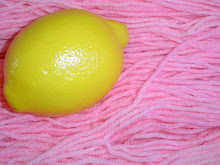Generic Sock Part 2
 This is the second time I've done this post, since the first got rudely eaten by the computer. Today is heel flaps and heel turns. I work my heel flap on half of the total number of stitches in the sock (in this case 32 stitches for the heel). When I've finished my last round of leg stitches, I turn my sock around and slip 1 and purl 31 (if you have a different number of heel stitches, the number you'll purl will be different - just make sure you slip the first one and purl the rest until you have half of the total sock stitches for your heel flap. This WS row is the first row of my heel flap. The next row is a RS Row and goes like this: *Slip 1, Knit 1, rep from* to end of row. These two row form Heel Stitch and you'll want to knit as many rows as you have stitches in your heel flap (in my case 32 stitches, 32 rows for the heel flap) - this gives you a roughly square heel flap.
This is the second time I've done this post, since the first got rudely eaten by the computer. Today is heel flaps and heel turns. I work my heel flap on half of the total number of stitches in the sock (in this case 32 stitches for the heel). When I've finished my last round of leg stitches, I turn my sock around and slip 1 and purl 31 (if you have a different number of heel stitches, the number you'll purl will be different - just make sure you slip the first one and purl the rest until you have half of the total sock stitches for your heel flap. This WS row is the first row of my heel flap. The next row is a RS Row and goes like this: *Slip 1, Knit 1, rep from* to end of row. These two row form Heel Stitch and you'll want to knit as many rows as you have stitches in your heel flap (in my case 32 stitches, 32 rows for the heel flap) - this gives you a roughly square heel flap. You should have finished on a RS row so to start your heel turn, you'll be working a WS row. Row 1 of Heel Turn: Slip 1, Purl half the number of heel flap stitches (on my sock that's slip 1, Purl 16), Purl 2 Together, Purl 1, turn. Row 2 of Heel Turn: Slip 1, Knit 3, SSK, Knit 1, turn. Now you will have two little "gaps," one on either side of your center stitches where you turned your work. Work the following two rows as many times as it takes to use all of the heel flap stitches.
Row 1: Slip 1, Purl to 1 stitch before the gap, P2tog, Purl 1, turn.
Row 2: Slip 1, Knit to 1 sitch before the gap, SSK, Knit 1, turn. Each row will add two more stitches from your heel flap to your heel turn.
Once you have used all the stitches, you're ready to start the gusset - we'll do that tomorrow!










3 Comments:
I'm sending a friend over to learn socks from your blog as we just can't seem to get together this week. Thanks for posting at just the right time!
Your kitty looks just like my old cat Digger. I miss her! We moved here to the country and got dogs. Digger didn't like going outside to go to the bathroom in the snow, she would go in the tub (yuck). So we gave her to my BIL who lives in Everett where we used to live. He takes very good care of her. I just love the pictures of your little kitty. In this post he's doing just what Digger would do!
is there a certain name for that kind of heel? that's the style heel i use, but i've heard of the "eye of the partridge" heel and always wondered what that was. also, i think it would be neat to see a sock wheel of all the socks you've knit (and still have around) like on sockbug's blog. you can email me at knittykarenAThotmailDOTcom
Post a Comment
<< Home